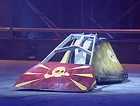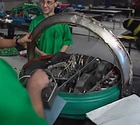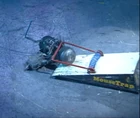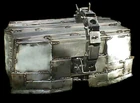Middle Eye (talk | contribs) |
Middle Eye (talk | contribs) (Picture that actually shows weapon in action) |
||
| Line 93: | Line 93: | ||
|[[Haardvark]] |
|[[Haardvark]] |
||
|Grinding blade |
|Grinding blade |
||
| − | |[[File: |
+ | |[[File:Henry_vs_Haardvark.png|140px]] |
|Series 3 |
|Series 3 |
||
|The blade was originally meant to be a circular saw, but it had to be removed due to health & safety regulations. It was also attatched to a plastic blade. It was an abrasive saw that was designed to grind away the armour of robots |
|The blade was originally meant to be a circular saw, but it had to be removed due to health & safety regulations. It was also attatched to a plastic blade. It was an abrasive saw that was designed to grind away the armour of robots |
||
Revision as of 16:10, 22 May 2011
In Robot Wars, some robots created weapons that did not fit into any category. These are known as unique weapons.
They may still act as overhead or rotating weapons, but functioned in very different ways. The most famous unique weapons would include Mousetrap and Tentomushi.
Definition
A unique weapon is designated by the fact that it does not fit one exclusive category of weapon. The weapon of Mousetrap for example, functioned in the same way as a hammer (Series 4) or bladed axe (Series 5/Extreme 1), but also as jaws when it clamped down on robots.
In addition, there may be weapons that do not fit any category whatsoever, such as the weapons of Tentomushi or Darke Destroyer 2.
Advantages and Disadvantages
Advantages
- Roboteers can often use the custom weapon to fit in with the design of their robot, for both effectiveness and entertainment. Mousetrap is the best example of both.
- Creating a new type of weapon grants a robot the element of surprise.
Disadvantages
- It is very difficult to know whether a weapon will be effective in combat without predecessors to compare with.
List of robots with Unique weapons
Robots are listed alphabetically. Robots that aren't heavyweight are listed with a green background.
| Robot | Weapon | Picture | Series Appearances with Unique weapon | Description | Advantages | Disadvantages |
|---|---|---|---|---|---|---|
| 8645T | Combination axe/flipper arm | 
|
Series 5, 7 | The flipper and axe were attached to the same piston so that when it was fired, the axe would go down and the flipper up simultaneously. | Protected both sides at the same time. The weapons offered good leverage to one another. | It didn't allow 8645T to self-right from any position except on its back. |
| Big Brother | Morningstar mace | 
|
Series 3 | The morningstar functioned as an overhead flail, which would whip back and forth. | Fast | Caused no damage, the mace was prone to falling off |
| Binky | Nose axe and Battle sled | 
|
Series 3 | Binky's battle sled was a large wedge scoop attached to a frame. The frame, itself attached to Binky's turret body, was capable of rotating around so that Binky's battle sled had a 360 degree range. | Provided a good deal of protection when facing an opponent, as it kept robots at least three feet away from the mechanics. | Was very slow in moving around, often required torque from the actual robot. Taking up a good deal of Binky's 80kg limit, often the body rotated and the battle sled remained still. |
| Broadsword | Medieval broadsword | 
|
Extreme 2 | The sword was a long blade made out of car springs. It was similar to a spear, but had bladed edges, and could damage opponents by swinging the side of the blade into them | Was reasonably effective | Was long and unwieldy, it struggled to hit low robots |
| Daisy | Heavy overhead "Skipping rope" | 
|
Series 3 | Described as a skipping rope, Daisy's weapon was a thick metal blade which swung over the robot to strike opponents. Very little is known about the weapon as it, and Daisy, were never seen in action. | It appeared to be able to strike both front and back Its design would have allowed it to act as a srimech |
Potential reliability issues, although unknown whether this was the reason Daisy pulled out Would have struggled against large opponents, such as its would-be opponent, Aggrobot. |
| Darke Destroyer 2 | Spring-loaded "wagglers" | 
|
Series 4 | The wagglers were two spring-loaded, sharp pieces of metal that would be fired when they came into contact with another robot, hopefully slicing into the shell | Could be fired at an incredible rate | Were very weak, and never caused any damage |
| Dome | Pneumatic trebuchet | 
|
Series 5 | The trebuchet functioned as an overhead flail, with the "ammunition" a disc attatched to the main arm by a chain | Very fast | Didn't cause much damage |
| Little Nipper | Twin mousetraps | 
|
Extreme 1 | Little Nipper wielded two mousetraps that looked like an actual mousetrap. They would bludgeon down on its opponent. | Fast | Ineffective, retracted very slowly |
| Haardvark | Grinding blade | 
|
Series 3 | The blade was originally meant to be a circular saw, but it had to be removed due to health & safety regulations. It was also attatched to a plastic blade. It was an abrasive saw that was designed to grind away the armour of robots | Made lots of sparks, which would help emphasize damage and aggression in the event of a judges' decision | Fragile, struggled against tough armour, needed to be held in place to work properly. |
| Havoc | Zinc mace | File:Havoc mace.gif | Series 2 | Interchangable with a flipper, the mace was a spiked ball attatched to a rod on the top of Havoc by a chain, allowing it to move freely. | Large attack radius | Ineffective |
| Mousetrap | Trap mechanism | 
|
Series 4-5 | The mechanism was designed to resemble the actual mechanism of a conventional mousetrap. Functioned as an overhead weapon, with a heavy bar, and then a guillotine blade in Series 5, as the impacting part of the weapon. Reached a Series Semi-Final and recorded four wins, including a victory over the seeded Evil Weevil, with this weapon. | Was effective as a trapping mechanism; Mousetrap could easily drag robots across the arena once it had slammed the trap down. | Could not function as a srimech. Was vulnerable to damage, as shown in the battle with S3. |
| Piranha | Knife blade | 
|
Extreme 2 | The weapon functioned as a large blade that was fired like an axe. | Was fast-acting | Not very powerful |
| Roter Osche | 'Demolition Hammer' | 
|
Series 2 | The weapon worked like a jackhammer to dent and buckle other robots' armour. It was strong enough to damage the arena sidewall, but was not seen in action on the televised broadcast. | Proved very powerful and destructive. | Only worked on slow or immobile opponents. Mounted high, likely too high to hit most low-profile robots. |
| Sir Chromalot | Combination axe/flipper | 
|
Series 5, Extreme 1 | The flipper's gas bottle was mounted on the flipping arm, and had a spike attatched to the rear end of it. It functoined akin to 8645T and Robochicken. | Reasonably effective | Inaccurate |
| Sting | Whipping tail | 
|
Series 2-3 | The tail was basically a spiked chain that would whip back and forth quickly. | Very fast | Inaccurate, weak |
| Tentomushi | 'Smothering Shell' | 
|
Series 3 | It also had a small spinning disc, but the main weapon was the 'smothering shell'; this was lined with foil on the underside of the shell to cripple the reception of the aeriel of the trapped robot. Recorded two wins, one of which being a draw, including a Middleweight Championship title and a victory in the Series 3 War of Independance. | Could easily immobilise an opponent by trapping it with the foil on the underside of the 'smothering shell'. | Was necessarily fragile. |
| Toe Cutter | Spring-loaded blade | 
|
Series 3 | The blade was a 5kg blade attached to a Clay Pigeon trap, which when fired would hopefully cut into the armour | Was very fast and could be fired in quick succession | Wasn't very powerful, very narrow range of attack. |
| Twister (Dutch) | Spinning Triangle | 
|
Dutch Series 2, Series 7 | Twister featured a triangular spinner with blunted vertices that acted as hammers. The entire outer triangle was thick enough to cause damage. The weapon was mounted at a 45-degree angle in Dutch Series 2 and horizontally in UK Series 7. Due to its unusual shape, Twister's weapon cannot accurately be classified as a flywheel or a heavy rotating blade. | The weapon was well-designed with much of its weight away from the central axis. | The 45-degree orientation left the robot precariously off-balance. The horizontal configuration left the space in between the vertices exposed - if that was the point of impact the triangle would glance harmlessly off the opponent and be unable to spin up. |
| This Robot Wars related article is a stub. You can help Robot Wars Wiki by expanding it. |
| ||||||||||||||||||||||||||||||||

